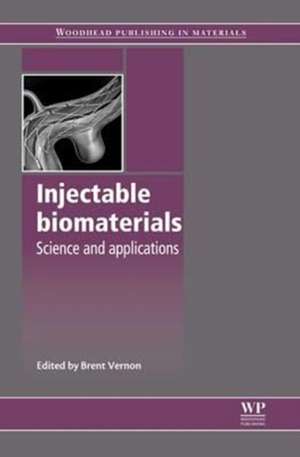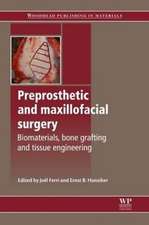Injectable Biomaterials: Science and Applications: Woodhead Publishing Series in Biomaterials
Editat de Brent Vernonen Limba Engleză Paperback – 18 aug 2016
Part one focuses on materials and properties, with chapters covering the design of injectable biomaterials as well as their rheological properties and the mechanical properties of injectable polymers and composites. Part two covers the clinical applications of injectable biomaterials, including chapters on drug delivery, tissue engineering and orthopaedic applications as well as injectable materials for gene delivery systems. In part three, existing and developing technologies are discussed. Chapters in this part cover such topics as environmentally responsive biomaterials, injectable nanotechnology, injectable biodegradable materials and biocompatibility. There are also chapters focusing on troubleshooting and potential future applications of injectable biomaterials.
With its distinguished editor and international team of contributors, Injectable biomaterials is a standard reference for materials scientists and researchers working in the biomaterials industry, as well as those with an academic interest in the subject. It will also be beneficial to clinicians.
- Comprehensively examines the materials, properties and biomedical applications of injectable materials, as well as novel developments in the technology
- Reviews the design of injectable biomaterials as well as their rheological properties and the mechanical properties of injectable polymers and composites
- Explores clinical applications of injectable biomaterials, including drug delivery, tissue engineering, orthopaedic applications and injectable materials for gene delivery systems
Din seria Woodhead Publishing Series in Biomaterials
- 5%
 Preț: 1209.61 lei
Preț: 1209.61 lei - 9%
 Preț: 1288.81 lei
Preț: 1288.81 lei - 20%
 Preț: 1116.12 lei
Preț: 1116.12 lei - 36%
 Preț: 1030.16 lei
Preț: 1030.16 lei - 5%
 Preț: 1403.92 lei
Preț: 1403.92 lei - 26%
 Preț: 990.05 lei
Preț: 990.05 lei - 5%
 Preț: 1047.40 lei
Preț: 1047.40 lei - 5%
 Preț: 1097.68 lei
Preț: 1097.68 lei - 36%
 Preț: 847.30 lei
Preț: 847.30 lei - 9%
 Preț: 1159.07 lei
Preț: 1159.07 lei - 5%
 Preț: 1341.04 lei
Preț: 1341.04 lei - 5%
 Preț: 1116.94 lei
Preț: 1116.94 lei - 5%
 Preț: 1115.67 lei
Preț: 1115.67 lei - 20%
 Preț: 901.66 lei
Preț: 901.66 lei - 5%
 Preț: 1114.31 lei
Preț: 1114.31 lei - 26%
 Preț: 903.89 lei
Preț: 903.89 lei - 36%
 Preț: 939.94 lei
Preț: 939.94 lei - 5%
 Preț: 1511.70 lei
Preț: 1511.70 lei - 5%
 Preț: 1071.15 lei
Preț: 1071.15 lei - 9%
 Preț: 1090.57 lei
Preț: 1090.57 lei - 9%
 Preț: 1044.12 lei
Preț: 1044.12 lei - 29%
 Preț: 847.49 lei
Preț: 847.49 lei - 9%
 Preț: 1003.98 lei
Preț: 1003.98 lei - 5%
 Preț: 1050.99 lei
Preț: 1050.99 lei - 5%
 Preț: 1600.80 lei
Preț: 1600.80 lei - 5%
 Preț: 986.00 lei
Preț: 986.00 lei - 5%
 Preț: 1118.83 lei
Preț: 1118.83 lei - 5%
 Preț: 1050.99 lei
Preț: 1050.99 lei - 20%
 Preț: 1038.08 lei
Preț: 1038.08 lei - 5%
 Preț: 902.90 lei
Preț: 902.90 lei - 9%
 Preț: 1070.42 lei
Preț: 1070.42 lei - 5%
 Preț: 1512.75 lei
Preț: 1512.75 lei - 29%
 Preț: 1282.87 lei
Preț: 1282.87 lei - 25%
 Preț: 1121.07 lei
Preț: 1121.07 lei - 5%
 Preț: 1253.32 lei
Preț: 1253.32 lei - 9%
 Preț: 1204.85 lei
Preț: 1204.85 lei - 26%
 Preț: 1046.86 lei
Preț: 1046.86 lei - 5%
 Preț: 835.44 lei
Preț: 835.44 lei - 5%
 Preț: 838.79 lei
Preț: 838.79 lei - 5%
 Preț: 940.93 lei
Preț: 940.93 lei - 20%
 Preț: 1290.67 lei
Preț: 1290.67 lei - 5%
 Preț: 1115.22 lei
Preț: 1115.22 lei - 5%
 Preț: 989.25 lei
Preț: 989.25 lei - 20%
 Preț: 1598.75 lei
Preț: 1598.75 lei - 20%
 Preț: 964.40 lei
Preț: 964.40 lei - 20%
 Preț: 903.00 lei
Preț: 903.00 lei - 5%
 Preț: 1333.41 lei
Preț: 1333.41 lei
Preț: 940.63 lei
Preț vechi: 990.14 lei
-5% Nou
Puncte Express: 1411
Preț estimativ în valută:
179.100€ • 185.97$ • 149.73£
179.100€ • 185.97$ • 149.73£
Carte tipărită la comandă
Livrare economică 12-26 martie
Preluare comenzi: 021 569.72.76
Specificații
ISBN-13: 9780081014936
ISBN-10: 0081014937
Pagini: 440
Dimensiuni: 156 x 234 x 22 mm
Greutate: 0.59 kg
Editura: ELSEVIER SCIENCE
Seria Woodhead Publishing Series in Biomaterials
ISBN-10: 0081014937
Pagini: 440
Dimensiuni: 156 x 234 x 22 mm
Greutate: 0.59 kg
Editura: ELSEVIER SCIENCE
Seria Woodhead Publishing Series in Biomaterials
Cuprins
Contributor contact details
Part I: Materials and properties
Chapter 1: Designing clinically useful substitutes for the extracellular matrix
Abstract:
1.1 Introduction: the translational challenge
1.2 Design criteria for extracellular matrix (ECM) mimetics
1.3 Single-module semi-synthetic extracellular matrices (sECMs) based on hyaluronic acid (HA)
1.4 Adding function to hyaluronic acid (HA) matrices
1.5 Using injectable synthetic extracellular matrices (sECMs) in vivo
1.6 Conclusions and future trends
Chapter 2: Designing ceramics for injectable bone graft substitutes
Abstract:
2.1 Introduction
2.2 Rheological properties of bone substitute pastes
2.3 Handling and delivery
2.4 Mechanical and biological properties of bone substitute pastes
2.5 Industrial design
2.6 Future trends
Chapter 3: Rheological properties of injectable biomaterials
Abstract:
3.1 Introduction
3.2 Different types of in situ gelling materials: chemical gels, solvent exchange, and physical gels
3.3 Shrinkage, swelling, and evaporation
3.4 Kinetics and injectability
3.5 The role of statistics and uncertainty in rheological characterization
3.6 Future trends
3.7 Sources of further information and advice
Chapter 4: Improving mechanical properties of injectable polymers and composites
Abstract:
4.1 Introduction
4.2 Mechanical properties and testing
4.3 Injectable hydrogels
4.4 Non–hydrogel injectable polymers
4.5 Conclusion and future trends
Part II: Clinical applications
Chapter 5: Drug delivery applications of injectable biomaterials
Abstract:
5.1 Introduction
5.2 Solvent exchange precipitating materials
5.3 Aqueous solubility change materials
5.4 In situ crosslinking or polymerizing materials
5.5 Microparticles and nanoparticles
5.6 Micelles and liposomes
5.7 Polymer-drug conjugates
5.8 Conclusion and future trends
Chapter 6: Tissue engineering applications of injectable biomaterials
Abstract:
6.1 Introduction
6.2 Requirements of injectable materials for tissue engineering
6.3 Injectable biomaterials: methods of gelation and tissue engineering applications
6.4 Injectable composites and applications in tissue engineering
6.5 Conclusion and future trends
6.7 Glossary
Chapter 7: Vascular applications of injectable biomaterials
Abstract:
7.1 Introduction
7.2 Embolization therapy for vascular conditions
7.3 Types of embolic materials
7.4 Future trends
Chapter 8: Orthopaedic applications of injectable biomaterials
Abstract:
8.1 Introduction
8.2 Classification
8.3 Clinical applications 1: fixation
8.4 Clinical applications 2: bone healing
8.5 Clinical applications 3: prevention and regeneration
8.6 Clinical applications 4: miscellaneous
8.7 Conclusion
Chapter 9: Dental applications of injectable biomaterials
Abstract:
9.1 Introduction
9.2 Challenges in the application of biomaterials to dentistry
9.3 Directly placed tooth-colored materials
9.4 Injectable materials in root canal therapy
9.5 Injectable calcium phosphate cements
9.6 Conclusion
Chapter 10: Injectable polymeric carriers for gene delivery systems
Abstract:
10.1 Introduction
10.2 Biological barriers
10.3 Nanoparticles
10.4 Microspheres
10.5 Hydrogels
10.6 Small interfering RNA (siRNA)
10.7 Conclusion
10.8 Acknowledgements
Part III: Technologies and developments
Chapter 11: Environmentally responsive injectable materials
Abstract:
11.1 Introduction
11.2 Temperature-sensitive polymers
11.3 Electrically sensitive polymers
11.4 pH-sensitive polymers
11.5 Light-sensitive polymers
11.6 Biomolecular-sensitive polymers
11.7 Other stimuli-sensitive polymers
11.8 Conclusion and future trends
Chapter 12: Injectable nanotechnology
Abstract:
12.1 Introduction
12.2 Route of administration and biodistribution of injectable nano-carriers
12.3 Diagnostic applications of injectable nano-carriers
12.4 Therapeutic applications of injectable nano-carriers
12.5 Injectable nanomaterials as matrix precursors
12.6 Conclusions
Chapter 13: Injectable biodegradable materials
Abstract:
13.1 Introduction
13.2 Poly(ethylene glycol) (PEG) copolymers
13.3 Poloxamer® and Pluronic® gels
13.4 Polypeptides
13.5 Other thermogelling polymers
13.6 Conclusions and future trends
13.7 Acknowledgements
Chapter 14: Troubleshooting and hurdles to development of biomaterials
Abstract:
14.1 Introduction
14.2 Material development hurdles
14.3 Device development hurdles
14.4 Funding challenges
Chapter 15: Biocompatibility of injectable materials
Abstract:
15.1 Introduction
15.2 Environmentally responsive biomaterials
15.3 Self-assembling biomaterials
15.4 Calcium phosphate bone cements
15.5 In situ polymerizable and crosslinkable biomaterials
15.6 Future trends
15.7 Sources of further information and advice
Chapter 16: Future applications of injectable biomaterials: the use of microgels as modular injectable scaffolds
Abstract:
16.1 Introduction
16.2 Background
16.3 Potential applications of microgels
16.4 Conclusions
16.5 Sources of further information and advice
Index
Part I: Materials and properties
Chapter 1: Designing clinically useful substitutes for the extracellular matrix
Abstract:
1.1 Introduction: the translational challenge
1.2 Design criteria for extracellular matrix (ECM) mimetics
1.3 Single-module semi-synthetic extracellular matrices (sECMs) based on hyaluronic acid (HA)
1.4 Adding function to hyaluronic acid (HA) matrices
1.5 Using injectable synthetic extracellular matrices (sECMs) in vivo
1.6 Conclusions and future trends
Chapter 2: Designing ceramics for injectable bone graft substitutes
Abstract:
2.1 Introduction
2.2 Rheological properties of bone substitute pastes
2.3 Handling and delivery
2.4 Mechanical and biological properties of bone substitute pastes
2.5 Industrial design
2.6 Future trends
Chapter 3: Rheological properties of injectable biomaterials
Abstract:
3.1 Introduction
3.2 Different types of in situ gelling materials: chemical gels, solvent exchange, and physical gels
3.3 Shrinkage, swelling, and evaporation
3.4 Kinetics and injectability
3.5 The role of statistics and uncertainty in rheological characterization
3.6 Future trends
3.7 Sources of further information and advice
Chapter 4: Improving mechanical properties of injectable polymers and composites
Abstract:
4.1 Introduction
4.2 Mechanical properties and testing
4.3 Injectable hydrogels
4.4 Non–hydrogel injectable polymers
4.5 Conclusion and future trends
Part II: Clinical applications
Chapter 5: Drug delivery applications of injectable biomaterials
Abstract:
5.1 Introduction
5.2 Solvent exchange precipitating materials
5.3 Aqueous solubility change materials
5.4 In situ crosslinking or polymerizing materials
5.5 Microparticles and nanoparticles
5.6 Micelles and liposomes
5.7 Polymer-drug conjugates
5.8 Conclusion and future trends
Chapter 6: Tissue engineering applications of injectable biomaterials
Abstract:
6.1 Introduction
6.2 Requirements of injectable materials for tissue engineering
6.3 Injectable biomaterials: methods of gelation and tissue engineering applications
6.4 Injectable composites and applications in tissue engineering
6.5 Conclusion and future trends
6.7 Glossary
Chapter 7: Vascular applications of injectable biomaterials
Abstract:
7.1 Introduction
7.2 Embolization therapy for vascular conditions
7.3 Types of embolic materials
7.4 Future trends
Chapter 8: Orthopaedic applications of injectable biomaterials
Abstract:
8.1 Introduction
8.2 Classification
8.3 Clinical applications 1: fixation
8.4 Clinical applications 2: bone healing
8.5 Clinical applications 3: prevention and regeneration
8.6 Clinical applications 4: miscellaneous
8.7 Conclusion
Chapter 9: Dental applications of injectable biomaterials
Abstract:
9.1 Introduction
9.2 Challenges in the application of biomaterials to dentistry
9.3 Directly placed tooth-colored materials
9.4 Injectable materials in root canal therapy
9.5 Injectable calcium phosphate cements
9.6 Conclusion
Chapter 10: Injectable polymeric carriers for gene delivery systems
Abstract:
10.1 Introduction
10.2 Biological barriers
10.3 Nanoparticles
10.4 Microspheres
10.5 Hydrogels
10.6 Small interfering RNA (siRNA)
10.7 Conclusion
10.8 Acknowledgements
Part III: Technologies and developments
Chapter 11: Environmentally responsive injectable materials
Abstract:
11.1 Introduction
11.2 Temperature-sensitive polymers
11.3 Electrically sensitive polymers
11.4 pH-sensitive polymers
11.5 Light-sensitive polymers
11.6 Biomolecular-sensitive polymers
11.7 Other stimuli-sensitive polymers
11.8 Conclusion and future trends
Chapter 12: Injectable nanotechnology
Abstract:
12.1 Introduction
12.2 Route of administration and biodistribution of injectable nano-carriers
12.3 Diagnostic applications of injectable nano-carriers
12.4 Therapeutic applications of injectable nano-carriers
12.5 Injectable nanomaterials as matrix precursors
12.6 Conclusions
Chapter 13: Injectable biodegradable materials
Abstract:
13.1 Introduction
13.2 Poly(ethylene glycol) (PEG) copolymers
13.3 Poloxamer® and Pluronic® gels
13.4 Polypeptides
13.5 Other thermogelling polymers
13.6 Conclusions and future trends
13.7 Acknowledgements
Chapter 14: Troubleshooting and hurdles to development of biomaterials
Abstract:
14.1 Introduction
14.2 Material development hurdles
14.3 Device development hurdles
14.4 Funding challenges
Chapter 15: Biocompatibility of injectable materials
Abstract:
15.1 Introduction
15.2 Environmentally responsive biomaterials
15.3 Self-assembling biomaterials
15.4 Calcium phosphate bone cements
15.5 In situ polymerizable and crosslinkable biomaterials
15.6 Future trends
15.7 Sources of further information and advice
Chapter 16: Future applications of injectable biomaterials: the use of microgels as modular injectable scaffolds
Abstract:
16.1 Introduction
16.2 Background
16.3 Potential applications of microgels
16.4 Conclusions
16.5 Sources of further information and advice
Index
















